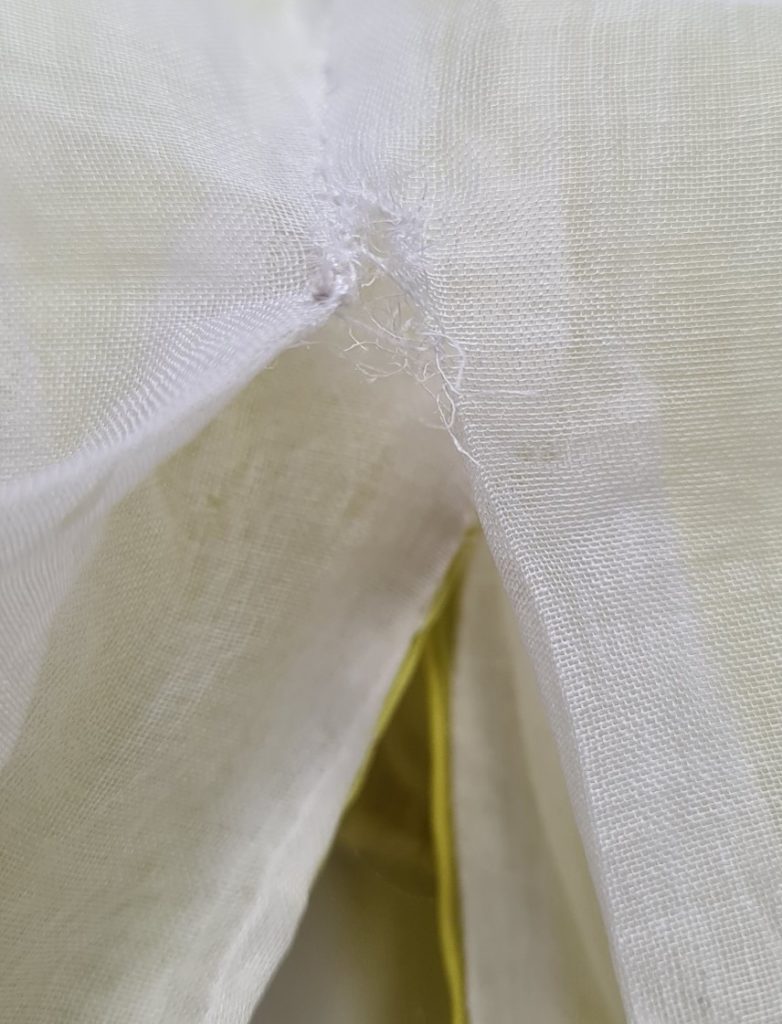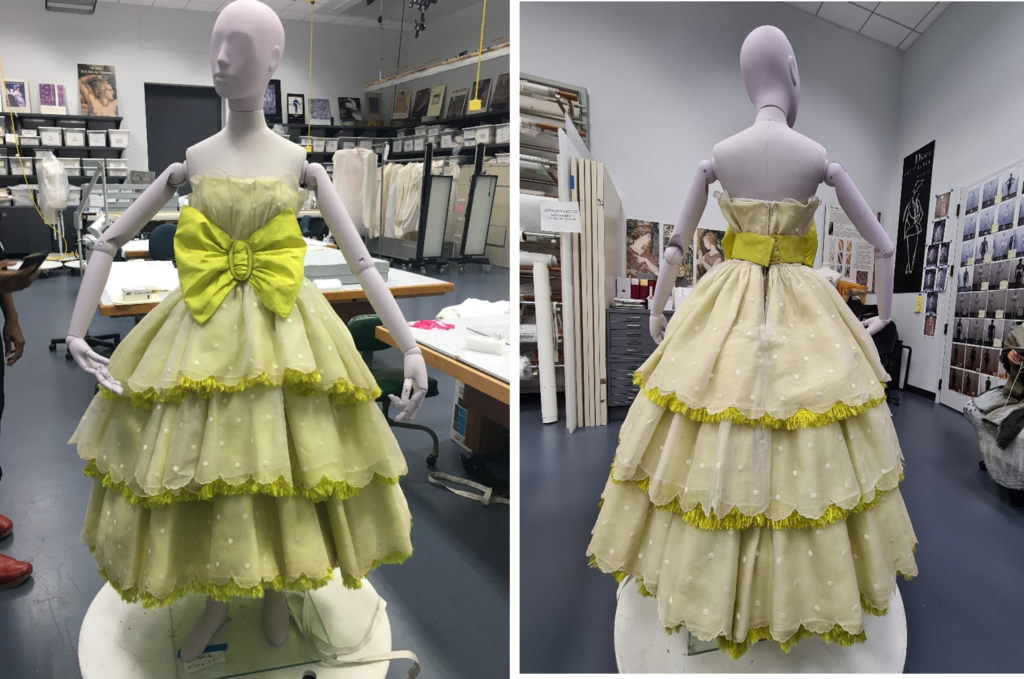
by Lauren Van Dessel, 2nd yr student, MPhil Textile Conservation
As part of the MPhil Textile Conservation programme, students complete their first year by undertaking a summer placement in a conservation lab. This summer, I was lucky enough to fulfil my placement at the Fine Arts Museums of San Francisco (FAMSF). One of the reasons I was drawn to FAMSF as a placement host was their outstanding costume collection, and I was hoping to challenge my developing skills as a student conservator by working on one of these structurally complex objects. This opportunity came to me in the form of a 1950s couture dress by the Belgian-French fashion designer Maggy Rouff (1896-1971), which I was tasked with conserving for an upcoming exhibition.

The name of the dress (Sucre d’orge) translates to “barley sugar” and is perhaps appropriately named after the eponymous boiled sweet. Comprised of chartreuse silk taffeta and white organdy, three flounces spill out from the nipped-in waist of the strapless bodice in a sumptuous shower of fabric. A separate stiffened net underskirt and large bow serve to accent and define this quintessential 1950s party dress silhouette. This ensemble was donated to the museum by the renowned San Francisco socialite and philanthropist Dodie Rosekrans (1919-2010), who is perhaps the most prolific donor of the FAMSF fashion collection. Famous for her bold and experimental style, it is fitting that her dress has been chosen for the 2023 exhibition exploring women’s sartorial freedom and San Francisco’s century of extravagance, which emerged after the devastating 1906 earthquake. It will draw together women’s twentieth-century fashion items from the permanent collection, many of which were donated by other famous San Franciscan figures, such as poet and suffragette Sara Bard Field (1882-1974), activist Dorothy Erskine (1896-1982), and philanthropist Elise Stern Haas (1914-1955).
The condition of the dress and its planned use required interventive treatment which involved localised cleaning, weave re-alignment, fringe straightening, and extensive support stitching. My intervention had to balance conserving its original, degrading materials while meeting the curatorial brief of exhibiting its ‘past fashionability’ and “newness” [2] which defines it as a haute couture item.
A large part of the treatment focused on introducing support stitching the reverse of the first flounce, which consisted of three layers: one layer of taffeta over which two layers of organdy lay. Each layer had at least one tear requiring a support patch, and these tears were concentrated near the zip base where the three flounce layers meet to form a complex structure. The fragility of the fabric, alongside the voluminous skirt made access to the area problematic. In addition, the different elements of its construction could not be viewed at once, making it difficult to understand the relation between the components. The placement of my support patches was dependent on my interpretative success, as well as adapting my manual skillset to work with the limited physical access.
The most challenging patch had to be introduced to the torn and fraying seam of the outermost layer of organdy, and which sat at the end of a slit which provided access to the base of the zip (Fig. 4, L). I inserted a patch with 2 “legs” under the folds either side of the slit (Fig.4, C and R). This way, the fabric around the tear would be more stable and provide more strength to this vulnerable edge—this was vital to making the dress safe for mounting.


Fig. 4 (L), A small seam tear above the base of the zip could cause big problems. The completed support patch as seen from the (C) outside and (R) underside © Lauren Van Dessel
After stabilisation, test mounting could begin Unlike many conservation departments, the textile conservators at FAMSF are privileged to have two costume mounters working alongside them. Subsequently, this presented me with a great opportunity to learn from a dress historian and theatre costume designer, both of whom have decades of practical experience with making and designing garments.
I was instructed on the key measurements to take from both the dress and prospective mannequins. These measurements would be our starting point, allowing us to establish which mannequin was small enough to accommodate the dress with padding. However, costume mounting is more than measuring; it also involves the astute analysis of form, expert planning, as well as some leaps of faith. Comparing the forms of the mannequin and dress was necessary to assess how far the mannequin’s shape could be manipulated to echo that of the dress.

Seeing the dress on a figure revealed so much more about its construction. The piped seam attaching the skirt to the bodice was sewn on in a cruder manner than would be expected of a couture item. Also highlighted was how the waist tape was a few inches smaller than the bodice (Fig.7), creating a large gap between the mannequin’s back and the bodice. Were these indications that the dress had been altered by the user? This was a small but poignant reminder of how objects are capable of surprising us and our interpretive work is always unfinished.
Being able to work extensively on the Maggy Rouff dress throughout my placement enabled me to deal with a range of material, historical, and institutional factors that influence treatment decisions, along with the unique practical, ethical, and conceptual challenges which working with costume entails. I feel privileged to have played a role in part of the city’s history.
Many thanks to Beth Szuhay, Laura García-Vedrenne, Erin Algeo, and Abra Berman, as well as my funders the Zibby Garnett Travel Fellowship, the Turing Scheme, and the Whistler Travel Scholarship.
References
[1] FAMSF, “Dress “Sucre d’Orge”.” https://art.famsf.org/maggy-rouff/dress-sucre-dorge-199214714a-c (accessed 20/10/2022).
[2] Sarah Scaturro, “A materials- and values-based approach to the conservation of fashion,” in ICOM-CC 18th Triennial Conference Preprints, Copenhagen, 4-8 September 2017, edited by J. Bridgland, (Pulido & Nunes; ICOM Committee for Conservation, 2017), 6.


Fascinating! thank you so much. I’m so glad to see this collection being celebrated. best wishes Mary Brooks
have just seen this report for the first time – very happy to know its had such close attention – congratulations on a job well done! Sarah Gates